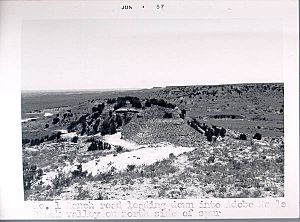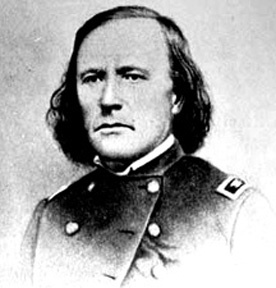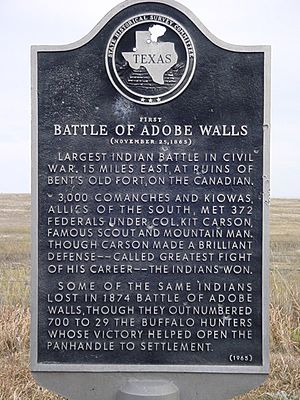First Battle of Adobe Walls facts for kids
Quick facts for kids First Battle of Adobe Walls |
|||||||
|---|---|---|---|---|---|---|---|
| Part of the American Indian Wars, Apache Wars | |||||||
 Adobe Walls |
|||||||
|
|||||||
| Belligerents | |||||||
| Kiowa Comanche Plains Apache |
|||||||
| Commanders and leaders | |||||||
| Dohäsan Satank Guipago Satanta Iron Shirt |
|||||||
| Strength | |||||||
| 335 soldiers 72 native scouts 2 artillery pieces |
<1,400 warriors | ||||||
| Casualties and losses | |||||||
| 6 killed 25 wounded |
Official Estimate: 60 killed and wounded 1 known dead |
||||||
The First Battle of Adobe Walls was a big fight between the United States Army and several Native American tribes. These tribes were the Kiowa, Comanche, and Plains Apache. They pushed back a U.S. Army group that was trying to stop attacks on settlers moving into the Southwest. This battle happened on November 25, 1864. Not many people were hurt on either side, but it was one of the biggest battles ever fought on the Great Plains.
Contents
Why Did the Battle Happen?
The First Battle of Adobe Walls took place on November 25, 1864. It was near the ruins of an old trading post called Adobe Walls. This place was once owned by William Bent. It is located in Hutchinson County, Texas.
The battle started because General James Henry Carleton wanted to stop attacks by the Kiowa and Comanche tribes. He believed they were attacking wagon trains on the Santa Fe Trail. The Native Americans saw these wagon trains as invaders. They felt the settlers were killing buffalo and other animals they needed to live.
During the American Civil War, fewer soldiers were available to protect settlers. This led to more attacks on the Great Plains. Settlers asked for help. General Carleton chose Colonel Kit Carson to lead the soldiers. Carson was a very experienced fighter against Native Americans. He was ordered to go after the winter camps of the Comanches and Kiowas. These camps were thought to be in the Palo Duro Canyon area of the Texas Panhandle.
Getting Ready for Battle
On November 10, 1864, Colonel Carson left Fort Bascom. He had 260 cavalry soldiers, 75 infantry soldiers, and 72 Ute and Jicarilla Apache scouts. He also had two small cannons called howitzers. His group had 27 wagons, an ambulance, and enough food for 45 days.
Carson decided to march to Adobe Walls first. He knew the area well from working there years before. His Native American scouts were very good. They rode ahead each morning to look for Comanche and Kiowa camps.
Bad weather, including an early snowstorm, made their journey slow. On November 24, the scouts found signs of a large Native American village. Carson left his infantry to guard the supplies. He ordered his cavalry and cannons to march through the night.
The Battle Begins
Around two hours after sunrise on November 25, Carson's cavalry found a Kiowa village. It had 176 lodges (tipis). The chief, Dohäsan, and his people quickly left. They warned other nearby Comanche villages. Guipago led warriors to protect the women and children who were fleeing.
Carson moved his troops forward to Adobe Walls, about four miles from the Kiowa village. He set up his defense there around 10:00 AM. He used part of the ruins as a hospital. To his surprise, he saw many Native American villages in the area. A huge number of warriors came to fight him. This was a much larger force than he expected.
One officer, Lieutenant Pettis, thought there were 1,200 to 1,400 Comanche and Kiowa warriors. Carson had only 330 soldiers and scouts ready to fight.
Throw a few shells into that crowd over there.
Carson had his cavalry get off their horses. He placed them around the two howitzers. His scouts fought with about 200 Comanche and Kiowa warriors. These warriors were "mounted and covered with paint and feathers." They charged back and forth, shooting from under their horses.
Dohäsan, with help from Satank, Guipago, and Satanta, led the Kiowas in the first attack. The fighting was intense. The Kiowa, Plains Apache, and Comanche warriors attacked Carson's position many times. Satanta even used his own bugle calls to confuse the soldiers. Carson was able to push back the attacks only because of his clever use of the howitzers. The cannons fired shells that made the warriors pull back. But they soon returned in even larger numbers.
By afternoon, Lieutenant Pettis believed Carson's army faced over 3,000 Native Americans. After many hours of fighting, Carson realized he was running low on cannon shells and ammunition. He ordered his forces to retreat back to the Kiowa village. Carson was also worried about the 75 men guarding his supply wagons.
The Native Americans tried to stop Carson's retreat. They set fire to the grass and bushes near the river. But Carson was smart. He set his own fires to burn paths for his retreat. He moved to higher ground, where the howitzers continued to hold off the warriors.
As evening came, Carson ordered about half his men and his scouts to burn the lodges in the Kiowa village. During this, the Kiowa Apache chief Iron Shirt was killed because he refused to leave his tipi. The soldiers took many buffalo robes and burned the rest. The scouts also killed four Kiowas who were too old to run away. The tired soldiers continued their retreat and found their supply train safe that night.
On November 26, Carson and his soldiers rested. Their Native American opponents were visible on a hilltop about two miles away. Carson's scouts had small fights with the Comanche and Kiowa. But no major attack happened. The next day, Carson ordered his troops to return to New Mexico. Some of his officers wanted to keep fighting. But Carson decided to retreat.
What Happened After the Battle?
Who Won the Battle?
The United States Army said the First Battle of Adobe Walls was a victory. However, the Kiowa tribe saw it differently. In their yearly records, they called that time the "muddy travel winter, the time when the Kiowas repelled Kit Carson." Carson was well known by all the Native Americans of the Southern Plains.
After this battle, the Comanche and Kiowa tribes remained in control of the Texas Panhandle. This lasted until the Battle of the North Fork of the Red River eight years later. Most experts agree that Carson made a smart choice to retreat. He was greatly outnumbered. His clever use of fires and the howitzers saved his force from being completely defeated.
The number of Native Americans fighting Carson has been estimated as high as 3,000. But this is probably too high. The total number of warriors from the Comanche, Kiowa, and Kiowa Apache tribes was likely not close to 3,000. The Kiowa village had 176 lodges, and the Comanche village had about 500. It's unlikely there were more than two fighters per lodge, which would be about 1,300 warriors.
Carson's side had six killed and 25 wounded. This included one scout killed and four wounded. Carson thought the Comanche and Kiowa had about 50 to 60 killed and up to 100 wounded. The official U.S. Army report said the Native Americans lost about 60 killed and wounded in total. Since the fighting was often from a distance, these numbers are just guesses.
The End of an Era
The First Battle at Adobe Walls was the last time the Comanche and Kiowa forced American troops to retreat. It marked the beginning of the end for the Plains tribes and their traditional way of life.
Ten years later, the Second Battle of Adobe Walls happened on June 27, 1874. In that battle, 28 hunters defended the settlement of Adobe Walls against 250 to 700 Comanche warriors. After four days, the Native Americans left. The Second Battle was important because it led to the Red River War of 1874–75. This war resulted in the Southern Plains Native Americans being moved to reservations in what is now Oklahoma.
Remembering the Battle
In 1964, the Texas State Historical Survey Committee put up a historical marker. This marker helps remember the First Battle of Adobe Walls. The marker is not exactly at the battle site. It is about 15 miles (24 km) to the west. The marker says that "though Carson made a brilliant defense, the Indians won."
Images for kids




